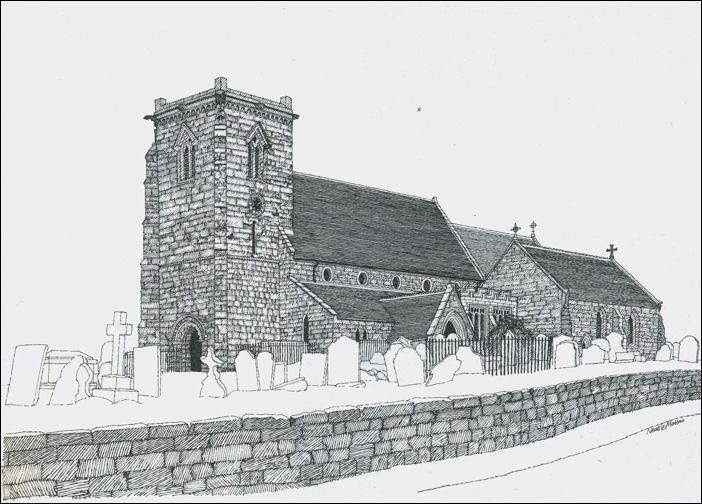|
|
|
![]() back to "The Grand Tour" index
back to "The Grand Tour" index
Neville Malkin's "Grand Tour" of the Potteries
buildings South of the Potteries
![]()
![]()
![]()
next: St. John's Church,
Barlaston
previous: Stone Railway
Station
contents: index of
buildings south of the Potteries
|
No 7 - St. Mary's Church,
Swynnerton
Staffordshire Past Tracks |

St. Mary's Church, Swynnerton
pen drawing by Neville Malkin - March 1975
|
"It is difficult
to realise you are living in a technological age when you take a walk
through the typically English village of Swynnerton, whose rural, old
world charm is enhanced by the fine Parish Church of St. Mary. A few traces of the original 12th century building can be seen in the present church, mainly the lower half of the tower and parts of the west wall. The upper part of the tower was added in the 16th century. The doorway leading from the base of the tower into the nave is a magnificent example of Norman workmanship. The arch of this door shows 16 wolves' heads each with two sharp ears pointing upwards and a sharp nose pointing down. The nave, chancel and south aisle were rebuilt in the middle of the 14th century. In the south wall of the chancel is the reclining figure of a crusader, believed to be Sir John de Swynnerton, Constable of the Tower of London and a Baron in the first Parliament, who was interred here about 1254. The figure, carved from local stone, measures 6ft. 2in. and is clothed in the complete armour of a crusader with a Norman shield hanging from his left arm. Beneath this effigy is a burial chamber which was accidently opened during restoration work in 1856. In the chamber was found a completely preserved body, which appeared to be that of a young knight with a weather-beaten complexion and auburn hair and beard; two front teeth were missing. After 600 years the accidental exposure caused the body to crumble. Beneath the chapel is a large vault that contains the remains of 16 members of the Fitzherbert family who were buried there between 1612 and 1865. Against another wall stands a fine statue of Christ which is probably late 13th century and a gift from Lichfield Cathedral. It was found under the floor where it had been hidden to avoid destruction from over-enthusiastic "Reformers." There is some fine stained glass by Powell, 1864, which was designed by Sedding and probably inspired by the work of Burne-Jones. There is no evidence to suggest that a church existed on this site before Norman times but the village can be traced back further to an era when the manor was used as the royal residence of a Saxon prince."
|
St. Mary's Church, Swynnertonphoto: © Andy and Hilary April 2005
and licensed for reuse under this Creative Commons Licence
|
From History, Gazetteer and Directory of
Staffordshire,
postcard: William Blake (c.1920-30) |
next: St. John's Church, Barlaston
previous: Stone Railway Station
contents: index of buildings south of the Potteries
back to "The Grand Tour" index